

| Home | Log In | Register | Our Services | My Account | Contact | Help |
You are NOT currently logged in
dai oldenrich - 01 Sep 2006 13:32
click your browser refresh button to update charts
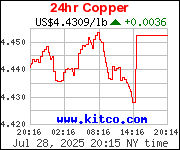
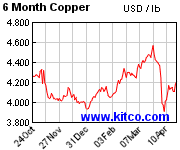
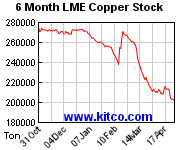
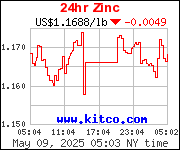
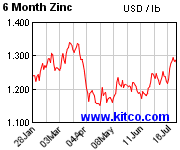
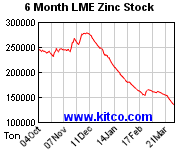
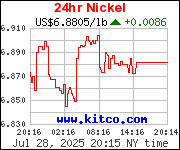
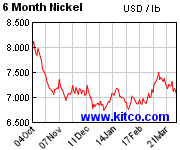
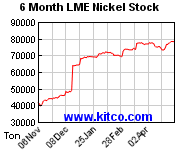
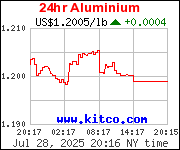
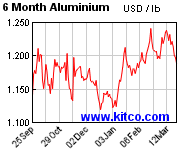
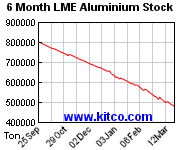
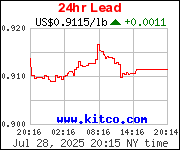
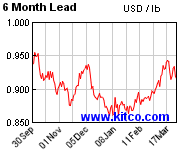
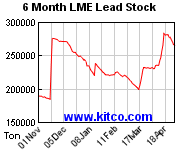
Also see: gold charts here silver charts here platinum charts here
dai oldenrich - 04 Oct 2006 06:22 - 74 of 181
Bloomberg - Oct. 4 - By Tan Hwee Ann and Kazue Somiya
Crude oil fell the most in almost 14 months to below $59 a barrel on expectations a U.S. government report today will show a jump in fuel stockpiles. The falling oil prices reduced the need for investors to hold gold bullion as an inflation hedge.
``There's a little bit of bargain buying now, and hopefully the physical buyers will return at these gold prices,'' Jonathan Barratt, a founder of Commodity Broking Services, said in Sydney. ``But if crude oil is to continue the decline, so will gold.''
Gold for immediate delivery rose as much $3.00, or 0.5 percent, to $577.50 and traded at $577.00 at 11:51 a.m. Sydney time. It fell 3.7 percent yesterday, the most since June 13.
Gold for delivery in December fell as much as $3.00, or 0.5 percent, to $578.50 an ounce in after-hours electronic trading on the Comex division of the New York Mercantile Exchange. It traded at $581.80 at 11:51 a.m. Sydney time.
Gold ``is tracking the downward trend in crude oil prices,'' said Mikikaru Amano, an analyst at Taiheiyo Bussan Co. in Tokyo. Oil prices ``are likely to keep declining as members of the Organization of Petroleum Exporting Countries, except for Nigeria and Venezuela, haven't cut production. Prices will head toward $55 a barrel.''
Supplies of distillate fuel in the U.S., which includes heating oil and diesel, and of gasoline, probably rose last week, according to the median of 12 responses in a Bloomberg News survey before the U.S. government report later today.
Crude oil for November delivery was at $58.38 a barrel, down 30 cents, or 0.5 percent, in after-hours electronic trading on the New York Mercantile Exchange at 11:51 a.m. Sydney time.
Yesterday, oil fell 3.9 percent to $58.68, the lowest close since Feb 16. It was the biggest one-day decline since Aug. 17, 2005.
dai oldenrich - 04 Oct 2006 06:26 - 75 of 181
Dow Jones Newswires - Wednesday, October 04
Oil May Send Gold As Low As $550 - Investec
Likely further oil retreat to around $55/bbl later in year expected to extend gold's pullback as inflation, geopolitical drivers continue to dissipate, says Investec Australia's Darren Heathcote; "it wouldn't surprise me to see gold suffer even more and possibly head toward targets at 560 and 550 dollars." However, $550 to find strong support; "based on fundamentals I think investors would be happier buying around those levels (and) the impetus would be more likely for a push up rather than down."
dai oldenrich - 04 Oct 2006 06:27 - 76 of 181
Dow Jones Newswires - Wednesday, October 04
Silver Charts Suggest More Selling Ahead
Silver looking technically weak after succumbing to gold, oil pressure overnight to close below key 200-day moving average level; last $10.85/oz, down another 11 cents. Needs to bounce back above $11.12 immediately or faces further weakness, says ScotiaMocatta in technical note. Pegs next support at $10.72, then $10.45.
dai oldenrich - 04 Oct 2006 21:57 - 77 of 181
Oil May Send Gold As Low As $550 - Investec
Dow Jones Newswires - Wednesday, October 04, 2006
Likely further oil retreat to around $55/bbl later in year expected to extend gold's pullback as inflation, geopolitical drivers continue to dissipate, says Investec Australia's Darren Heathcote; "it wouldn't surprise me to see gold suffer even more and possibly head toward targets at 560 and 550 dollars." However, $550 to find strong support; "based on fundamentals I think investors would be happier buying around those levels (and) the impetus would be more likely for a push up rather than down." Spot trades last at $575.80, down $1.10 on NY close.
dai oldenrich - 04 Oct 2006 21:57 - 78 of 181
Bloomberg - Oct. 4
Gold Falls on Signs Commodity Slump May Ease Inflation Pressure - By Pham-Duy Nguyen
Gold futures fell to the lowest since June on speculation a 16-month low in commodity prices will reduce the metal's appeal as a hedge against inflation.
The Reuters/Jefferies CRB Commodity Price Index dropped 2.1 percent yesterday and today touched 292.72, the lowest since June 2005. The index's 12 percent drop in the third quarter was the biggest in 50 years. Gold is down 23 percent from a 26-year high of $732 an ounce on May 12, partly because of a 26 percent drop in oil prices from a record in July.
``There's a liquidation in the commodities world that's brought on by moderating inflation,'' said Frank Lesh, a trader at FuturePath Trading LLC in Chicago. ``That's not good for gold.''
Gold futures for December delivery fell $14.80, or 2.6 percent, to $566.70 an ounce on the Comex division of the New York Mercantile Exchange. Prices earlier touched $563.50, the lowest since June 15. A futures contract is an obligation to buy or sell a commodity at a set price for delivery by a specific date.
Oil yesterday touched a seven-month low, triggering a 3.6 percent decline, the biggest percentage drop since June 13.
Gold's losses accelerated today after crude fell below $58 a barrel for the first time since February following an Energy Department report that showed an unexpected gain in U.S. inventories.
`Following Oil'
``Gold is definitely following oil around,'' said Lesh. ``Right now, that's the main driver.''
Some investors buy gold when energy expenses climb. Gold futures reached a record $873 an ounce in January 1980 when oil costs doubled in a year, sparking a surge in the inflation rate.
Prices may plunge further after falling below the 200-day moving average, according to analysts who look at historical charts.
``The price action looks extremely poor,'' John Reade, an analyst at UBS AG, said in a report to clients.
Technical charts show a bearish trend forming for gold and other metals, said Dan Chesler, an independent analyst in Wellington, Florida, who studies historical price patterns.
Peter Grandich, publisher of the Grandich Letter, a financial newsletter in Perrineville, New Jersey, told clients in a report today that prices may fall to the June low of $546.40, and may even reach $500 before resuming their long-term rally.
``Gold is in one of its more defensive positions since the bull market began several years ago,'' Grandich said. ``There's not only been significant technical damage done short term, but the next few trading sessions are likely going to impact where we head for much of the balance of 2006.''
Silver for December delivery fell 25 cents, or 2.3 percent, to $10.795 an ounce on the Comex. Palladium for December delivery fell $9.80, or 3.2 percent, to $296.65 an ounce on the Comex, and platinum for January delivery fell $46.60, or 4.1 percent, to $1,082.40 an ounce.
dai oldenrich - 04 Oct 2006 21:58 - 79 of 181
Bloomberg - Oct. 4
Copper Prices Fall as Growth in U.S. Service Industries Slows - By Choy Leng Yeong and Claudia Carpenter
Copper fell to a three-month low after a report showed U.S. service industries expanded last month at the slowest pace in more than three years as a housing slump deepened.
The Institute for Supply Management's index of non- manufacturing businesses fell to 52.9 in September, the lowest since April 2003, from 57 in August. Readings above 50 indicate expansion. Copper has slumped 21 percent from a record $4.04 a pound in mid-May as the housing market in the U.S., the world's second-biggest user of the metal, weakened.
``Funds are selling metals on anticipation of an economic slowdown in the U.S.,'' said Chris Brodie, who manages Krom River Partners LLP, a commodity hedge fund in London. ``We've not been long on metals since July.''
Copper futures for December delivery fell 7.7 cents, or 2.4 percent, to $3.2055 a pound on the Comex division of the New York Mercantile Exchange, after reaching $3.185, the lowest since June 29. Prices are still up 57 percent this year.
On the London Metal Exchange, copper for delivery in three months fell $310, or 4.2 percent, to $7,030 a metric ton, the biggest one-day drop since Sept. 11.
The Institute for Supply Management's manufacturing index dropped to 52.9 in September, the lowest since May 2005, the institute said Oct. 2.
``All the manufacturing, ISM numbers have been pretty crummy,'' said Michael Purdy, a trader at ABN Amro Bank in New York.
Home Construction Slows
U.S. home construction fell at an annual rate of 11 percent in the second quarter, the biggest drop since 1995, Commerce Department figures last week showed. As much as 400 pounds of copper is used in the average U.S. house.
``As the U.S. slows, demand for Chinese exports is going to slow,'' said William Adams, an analyst at Basemetals.com in Saffron Walden, England.
Copper usage in China, the biggest user of the metal, will drop 1.8 percent this year, the Lisbon-based International Copper Study Group said this week.
The price decline may be limited on speculation that producers of wire and pipe will resume purchases to replenish falling stockpiles. Inventories tracked by metal exchanges in London, New York and Shanghai are down 81 percent in the past three years as supplies lagged behind demand.
``There are bound to be consumers short of material who think the price is better than it was the last couple of weeks,'' said David Thurtell, a London-based analyst at BNP Paribas, an associate broker and clearing member of the London Metal Exchange.
Elsewhere on the LME, aluminum fell $90 to $2,475 a ton, nickel plunged $675 to $28,075 a ton, zinc dropped $86 to $3,304 a ton and lead declined $23 to $1,352 a ton. Tin rose $25 to $8,900 a ton.
A futures contract is an obligation to buy or sell a commodity at a fixed price for a specific delivery date.
dai oldenrich - 04 Oct 2006 21:58 - 80 of 181
FT - October 4 2006 - By Chris Flood
Gold failed to rally in response to news of North Koreas planned nuclear test, falling fell 1.4 per cent to $566.10 a troy ounce. Traders said a test of the March low about $541 an ounce was possible if sentiment towards commodities continued to deteriorate.
The European Central Bank said about 2.5m tonnes of gold were sold in the final week of the Central Bank Gold Agreement, which allowed signatories to sell 500 tonnes in the year to September 26. Total CBGA sales were estimated at betwen 400 to 405 tonnes, well short of the 500 tonne quota allowed.
Fears that central banks would rush to sell gold approaching the deadline as the quota cannot be rolled over to the next year have cast a shadow over the market in recent weeks.
GFMS, the precious metals consultancy said under the remainder of the GBGA arrangements were are unlikely to reach quota either on an annual basis or for the full ve year agreement.
We are perhaps on the threshold of an era of more moderate net ofcial sector selling, said GFMS.
Silver eased 0.9 per cent to $10.67 a troy ounce. Platinum retreated 3.2 per cent to $1,079 while palladium and palladium fell 2.3 per cent to $293 a troy ounce.
Copper led a retreat across base meals as the red metal lost 3.5 per cent to $7,080 a tonne, its lowest level for three months.
Nickel fell 1.7 per cent to $28,200 a tonne while zinc fell 2.6 per cent in spite of continued reductions in LME stocks down a further 900 tonnes yesterday. Aluminium was 3.5 per cent weaker at $2,475 a tonne.
dai oldenrich - 04 Oct 2006 21:58 - 81 of 181
Reuters - Wed Oct 4, 2006
COMEX copper ends down 2 pct, slowdown fears weigh
Copper futures in New York ended down over 2 percent on Wednesday, in sympathy with steep declines in the energy and precious metals markets, sources said.
"It was not copper-specific selling today. Everything took a hit today. Oil slid below $58 and gold started to slide, so we just followed suit," said one COMEX floor dealer.
Copper for December delivery ended the day down 7.70 cents, or 2.3 percent, at $3.2055 a lb on the New York Mercantile Exchange's COMEX division, after dealing from a new 10-1/2 week low at $3.1850 to $3.3550.
Dealers now placed new support in December copper at the July 24 low at $3.1450 all the way down to $3.00, while resistance continued to be seen at around $3.50.
Spot October slipped 8.85 cents to its session low at $3.1980, while back month contracts closed down 5.05 to 7.70 cents.
COMEX final copper volume was estimated at 21,000 lots, more than the 15,354 lots recorded on Tuesday.
COMEX copper futures opened with modest gains on some light bargain buying and short-covering following the previous session's sharp losses. But they failed to build on early gains and began their descent after weaker-than-expected U.S. economic data reinforced concerns over a slowing economy.
The Institute for Supply Management said its gauge of the services sector, which accounts for about 80 percent of the U.S. economy, slipped in September more than economists had expected.
"Concerns of macro-slowdowns will continue to limit the interest in this market. Until we see a change in the economic outlook, we will likely continue to trade in this recent range and testing new lows if data continues to come in weaker than expected," said one commodity broker.
Meanwhile, Chile's Codelco, the world's largest copper producer, set European annual copper premiums at a record $125 a tonne for 2007, up $20 from 2006, and U.S. premiums at 4.50 cents/lb ($100 a tonne) versus 4.25 cents for 2006.
LME three-months copper plummeted $310, or 4.2 percent, to settle Wednesday at $7,030 a tonne.
dai oldenrich - 04 Oct 2006 21:59 - 82 of 181
physorg.com - 4 October 2006
Less expensive fuel cell may be possible
Scientists at Los Alamos National Laboratory have developed a new class of hydrogen fuel-cell catalysts that exhibit promising activity and stability. The catalysts are made of low-cost nonprecious metals entrapped in something called a heteroatomic-polymer structure, instead of platinum materials typically used in fuel cells.
In research published recently in the scientific journal Nature, Los Alamos scientists Rajesh Bashyam and Piotr Zelenay describe tests conducted on a cobalt-polypyrrole-carbon (Co-PPY-XC72) composite. The composite, consisting of cobalt, polymer and carbon, was developed in research aimed at developing low-cost non-platinum catalysts for the polymer electrolyte fuel-cell (PEFC) cathode.
While the electrical energy producing activity of the catalyst is lower than that of platinum-based catalysts used in polymer electrolyte fuel cells, the new material shows exceptional performance stability for over one hundred hours of continuous testing, a result never before obtained with non-precious metal catalysts in PEFCs.
"Besides being made of inexpensive and environmentally benign materials," said Zelenay, "the chief advantage of these composite catalysts for oxygen reduction is that they can operate in the acidic environment of the polymer electrolyte fuel cell."
Bashyam and Zelenay are investigating the nature of catalysts in a variety of composites. They are also part of a larger Laboratory effort aimed at developing new catalyst and electrode structures that could increase the current output from fuel cells.
According to Ken Stroh, program manager for the Los Alamos fuel-cell effort, "The two biggest obstacles in making a commercially viable fuel cell have traditionally been high cost and inadequate durability. Our focus at Los Alamos is to attack those obstacles as a system in which you simultaneously strive for lower costs and higher durability."
dai oldenrich - 04 Oct 2006 21:59 - 83 of 181
Source: Globe and Mail - 4 October 2006
Commodity bear market begins now: Merrill
Commodity prices are due for a "protracted bear market" after speculators drove prices artificially high in recent months, Merrill Lynch & Co.'s chief investment strategist said Wednesday.
"We commented early last month that the level of speculation in commodities was at an all-time high," said Richard Bernstein in a report. "Despite September's pullback in overall commodity prices, the level of speculation has actually risen!"
Merrill was not the only brokerage betting that the commodity space is getting riskier. An RBC Dominion Securities analyst turned bearish on the Canadian oil field services sector Wednesday, urging investors to view companies working in the field with caution, given the sharp drop in natural gas prices.
"In light of further risks to gas prices, exploration and production spending, and pressures on service pricing and margins created by potentially lower activity levels and more capacity, defensiveness and caution should continue to be the main theme over the next 6-9 months," RBC's Angela Guo wrote in a note.
Merrill's Mr. Bernstein measured the level of speculation in the market by comparing spot prices of commodities that trade exchange-listed futures with spot prices of commodities that do not. He believes that speculation is more likely to occur in the futures markets than in the physical markets.
"By our reckoning, commodities' prices are now about 60 per cent above what could be explained by fundamental supply and demand," the Merrill report said.
Its research suggests that September's drop in commodity prices might "only be the beginning" of a long-term drop in prices.
"We find it amusing that a consensus has now formed that housing is speculative and overdue for an extended pullback, yet many commodities have appreciated much more than housing has, and have done so in a shorter period of time," Mr. Bernstein said.
"Housing is speculative, but commodities are purely a fundamental story? We disagree."
The report comes a day after Merrill's U.S. sector strategist Brian Belski downgraded the U.S. energy sector to "underweight." He predicted the energy sector will underperform the stock market over the coming months.
RBC took a closer look at investing in the companies that provide products and services for the major oil and natural gas companies. The sector has provided another way for investors to profit from the boom in the resource sector.
But the price of natural gas the most common U.S. home heating fuel has dropped nearly 25 per cent since August 1 to its lowest level in nearly two years as North American inventories swelled on the extended warm weather. The drop in natural gas has forced some companies such as Canadian Natural Resources Ltd. to slash their natural-gas drilling plans.
RBC's Ms. Guo said a new look at the risk-reward profile of companies in the oil-field services sector triggered wide-spread downgrades in the sector.
Akita Drilling Ltd., Trinidad Energy Trust, Mullen Group Income Fund, Pason Systems Inc., CHC Helicopter Corp., and Flint Energy Services Ltd. were all downgraded to 'underperform.' Ensign Energy Services Inc., Precision Drilling Trust, Calfrac Well Services Ltd., Trican Well Service Ltd., Cathedral Energy Services Income Trust, and Total Energy Services were all cut to 'sector perform.'
Although the sector looks cheap now, there is no compelling reason to pick up the stocks, Ms. Guo said, nothing that a lack of near-term positive catalysts and continued uncertainty on earnings estimates will likely keep the sector depressed.
"As a dramatic measure of maximum risks should the oil price fall significantly due to macro economic reasons, while the gas price dips further due to a warm winter, applying the historical trough trailing multiples to the stocks would imply an average downside of 24 per cent for the sector from current levels."
Ms. Guo left her 'outperform' recommendations on Savanna Energy Services Corp., Enerflex Systems Ltd., CCS Income Trust and ShawCor Ltd., saying the stocks were already either oversold or more defensive in nature.
The last four companies have a more "favourable" relative risk-reward profiles when compared with the rest of their peer group and could be purchased by "value-oriented investors seeking exposures to the sector," she said.
dai oldenrich - 05 Oct 2006 07:16 - 84 of 181
Daily Telegraph - 05/10/2006
Angry copper users force inquiry into metal exchange - By Ambrose Evans-Pritchard
The London Metal Exchange is to face an European Union investigation over alleged monopoly practices after receiving a dossier of complaints from angry copper users. The International Wrought Copper Council has accused the LME and its network of warehouses of exploiting a stranglehold on the market to push up charges and boost profits for brokers.
The EU's competition directorate is examining whether the LME breached Articles 81 and 82 of EU treaty law banning the restriction of the free market and abuse of dominant position. A Commission spokesman confirmed the investigation but said the details were confidential.
Simon Payton, the IWCC's secretary-general, said the complaint stemmed from a long-running battle with the LME over warehouse practices and had nothing to do with the soaring price of copper, which has quadrupled in four years. The LME handles 90pc of copper and almost 100pc of aluminium traded across the world at its raucous sessions, where traders bark orders inside a ring of leather seats. Turnover last year as the commodity boom reached fever pitch was a staggering $4,500bn (2,390bn).
The exchange has been locked in conflict for years with the IWCC, a group top-heavy with European industrial users said to resent the dominant role of London. This year the IWCC issued a thinly-veiled threat to take its business elsewhere, complaining that hedge funds and speculators had driven copper prices far above its value in a "feeding frenzy".
In a letter to the Financial Services Authority, it said industrial users were struggling to finance deliveries as prices gyrated wildly, sometimes rising and falling as much as $500 a tonne in a single day. "This market, where speculators can buy what does not exist, is doing serious damage to our industry and will bring into question whether the LME copper price should continue to be the recognised reference price," it said.
The LME said it was baffled by the EU complaint, insisting that it set the overall standard of warehouses but did not fix the fees. "We don't own the warehouses and we cannot tell them what to charge. It's a free market with completely free competition," said a spokesman.
Robin Bhar, a base metals analyst at UBS, said the copper users were alone in their fury. "They seem to have a real gripe with the LME even though charges have come down. I've not heard protests from aluminium or zinc users, or trade associations," he said.
The copper price was trading at $7,391 a tonne yesterday. Although down 8pc from its peak in May, it has held up better than oil and most other commodities as economic growth continues to steam ahead in China and India.
However, the high price is leading to a steady switch to fibre optic and wireless technologies that use less metal, while air-conditioner manufacturers, who account for 5pc of the global market, are learning to use much thinner tubes.
dai oldenrich - 06 Oct 2006 07:29 - 85 of 181
Chinese copper enterprises cut production to resist raw material price hike
Some of China's copper melting enterprises have begun to cut their production in an effort to resist price hikes of imported raw materials, according to sources from the copper industry.
A senior manager of a Chinese copper company said this move is in response to BHP Billiton's cancel of price participation article and suppress of copper processing fees.
He said over the past more than 30 years, raw material suppliers and melting companies have always pursued the price participation article. But recently the BHP Billiton not only largely suppressed the processing fees, but also unilaterally proposed to cancel the PP article in a bid to solely enjoy the huge profits brought about by copper price hikes.
"This is unprecedented in international negotiations, it is harmful to the mutually-beneficial cooperation and friendship between suppliers and melting companies, and is a malicious damage to long-term contract structure," he said.
Head of the China Smeltery Purchase Team (CSPT) Yang Jun said if there is no PP article, what smelting enterprises get can not even meet their production cost.
In a CSPT meeting held on Sept. 26, the nine member enterprises all demanded to raise processing fees to a reasonable level, he said. The nine enterprises account for over 80 percent of China's imported copper raw materials.
dai oldenrich - 06 Oct 2006 07:31 - 86 of 181
AFX News Limited - 10.06.2006
China's copper smelters cut output after BHP abrogation of price deal - report
BEIJING (XFN-ASIA) - Some copper smelters have begun to reduce output as a result of a key offshore supplier BHP Billiton abrogating an agreement which has pushed up the cost of processing the metal, the China Daily reported, citing sources from the copper industry.
One manager from a local smelting company told the newspaper that the production cuts follow BHP Billiton's unilateral decision not to follow a price participation agreement and its decision to cut its copper processing payments.
The manager said for more than 30 years, raw material suppliers and smelting companies have abided by the PP agreement. But recently he claimed Billiton decided it would no longer follow the agreement and would also cut copper processing payments in order to maximise income from the present high global price for the metal.
'This is unprecedented in international negotiations, and is harmful to the mutually-beneficial cooperation and friendship of copper suppliers and melters,' the manager was quoted as saying, adding it would damage long term contracts.
The report also cited the head of the China Smeltery Purchase Team, Yang Jun, as saying without the PP agreement smelters will not even be able to meet the cost of production.
China's copper smelters cut output after BHP abrogation of price deal - report
BEIJING (XFN-ASIA) - Some copper smelters have begun to reduce output as a result of a key offshore supplier BHP Billiton abrogating an agreement which has pushed up the cost of processing the metal, the China Daily reported, citing sources from the copper industry.
One manager from a local smelting company told the newspaper that the production cuts follow BHP Billiton's unilateral decision not to follow a price participation agreement and its decision to cut its copper processing payments.
The manager said for more than 30 years, raw material suppliers and smelting companies have abided by the PP agreement. But recently he claimed Billiton decided it would no longer follow the agreement and would also cut copper processing payments in order to maximise income from the present high global price for the metal.
'This is unprecedented in international negotiations, and is harmful to the mutually-beneficial cooperation and friendship of copper suppliers and melters,' the manager was quoted as saying, adding it would damage long term contracts.
The report also cited the head of the China Smeltery Purchase Team, Yang Jun, as saying without the PP agreement smelters will not even be able to meet the cost of production.
dai oldenrich - 06 Oct 2006 07:32 - 87 of 181
Oct. 6 (Bloomberg)
Gold Drops in Asia as Oil Slips, Investors Deem Gains Overdone - By Tan Hwee Ann and Thomas Kutty Abraham
Gold fell in Asia as oil prices declined and some investors deemed yesterday's rally in the precious metal overdone.
Gold, which is seen as a hedge against inflation, has dropped 20 percent from a 26-year high of $732 an ounce on May 12, falling in line with oil's 23 percent drop since it reached a record July 14. Gold, which rose 1.3 percent yesterday, is heading for a fall of 4.6 percent this week.
``It continues to be influenced by the oil market,'' said Mark Pervan, head of research at Daiwa Securities SMBC, in Melbourne. ``It's been volatile and sentiment is swinging day to day.''
Gold for immediate delivery fell as much as $5.10, or 0.9 percent, to $569.20 an ounce and was trading at $571.20 at 11.10 a.m. Mumbai time.
The metal's five-day moving average price has been trading below its 200-day moving average since Sept. 13. The pattern suggests bullion may have slipped into a declining trend, some traders said. Its five-day moving average is $576.82 an ounce, compared with the 200-day figure of $600.80.
Spot gold prices touched $559.40 an ounce on Oct. 4, the lowest since June 15.
``Liquidation by funds will continue as there are no recovery signals in horizon,'' Kishore Narne, head of research at Anand Rathi Commodities Ltd., said in Mumbai. ``I expect gold to drop to $535-540 levels in the next two-three weeks.''
Gold for delivery in December traded at $575.40, little changed from yesterday's close, at 11:10 a.m. Mumbai time in after-hours electronic trade on the Comex division of the New York Mercantile Exchange.
A futures contract is an obligation to buy or sell a commodity at a set price for delivery by a specific date.
In India, the price of the metal for December delivery fell 15 rupees, or 0.2 percent, to 8,718 rupees per 10 grams, or 27,113 ($594) an ounce, at 11:15 a.m. Mumbai time on the Multi Commodity Exchange.
Gold Drops in Asia as Oil Slips, Investors Deem Gains Overdone - By Tan Hwee Ann and Thomas Kutty Abraham
Gold fell in Asia as oil prices declined and some investors deemed yesterday's rally in the precious metal overdone.
Gold, which is seen as a hedge against inflation, has dropped 20 percent from a 26-year high of $732 an ounce on May 12, falling in line with oil's 23 percent drop since it reached a record July 14. Gold, which rose 1.3 percent yesterday, is heading for a fall of 4.6 percent this week.
``It continues to be influenced by the oil market,'' said Mark Pervan, head of research at Daiwa Securities SMBC, in Melbourne. ``It's been volatile and sentiment is swinging day to day.''
Gold for immediate delivery fell as much as $5.10, or 0.9 percent, to $569.20 an ounce and was trading at $571.20 at 11.10 a.m. Mumbai time.
The metal's five-day moving average price has been trading below its 200-day moving average since Sept. 13. The pattern suggests bullion may have slipped into a declining trend, some traders said. Its five-day moving average is $576.82 an ounce, compared with the 200-day figure of $600.80.
Spot gold prices touched $559.40 an ounce on Oct. 4, the lowest since June 15.
``Liquidation by funds will continue as there are no recovery signals in horizon,'' Kishore Narne, head of research at Anand Rathi Commodities Ltd., said in Mumbai. ``I expect gold to drop to $535-540 levels in the next two-three weeks.''
Gold for delivery in December traded at $575.40, little changed from yesterday's close, at 11:10 a.m. Mumbai time in after-hours electronic trade on the Comex division of the New York Mercantile Exchange.
A futures contract is an obligation to buy or sell a commodity at a set price for delivery by a specific date.
In India, the price of the metal for December delivery fell 15 rupees, or 0.2 percent, to 8,718 rupees per 10 grams, or 27,113 ($594) an ounce, at 11:15 a.m. Mumbai time on the Multi Commodity Exchange.
dai oldenrich - 06 Oct 2006 07:33 - 88 of 181
Oct. 6 (Bloomberg)
Copper Declines in Asia After Trader Charts Give Sell Signals - By Feiwen Rong
Copper in Asia declined after charts some traders use to predict price movements gave sell signals.
A price movement ``above $7,400 is needed to reverse the downtrend since Sept. 27,'' analysts at Barclays Capital in London said in an e-mailed report yesterday. Without such a movement, ``the market is precariously on edge.''
Copper futures on the London Metal Exchange fell as much as $29, or 0.4 percent, to $7,270 a metric ton, and traded at $7,275 at 11:37 a.m. Singapore time.
dai oldenrich - 06 Oct 2006 07:42 - 89 of 181
Daily Telegraph - 06/10/2006
Banks may be behind plunge in gold price - By Ambrose Evans-Pritchard
Central banks may have dumped far more gold on the markets over the last three weeks than officially reported, accounting for the sudden plunge in prices that has stunned investors.
advertisement
Barclays Capital said Europe's banks had sold an extra 100 tonnes from reserves in a rush to meet a quota deadline on Sept 26, but had done so by selling through forward contracts that disguised the effect.
"We have been able to infer this from trading patterns. It has had a major impact on the markets," said Costanza Jacazio, the bank's gold expert. Barclays is one of the world's three top bullion traders.
"We suspect that the Banque de France has been involved," she said.
The huge sales would help explain gold's brutal fall from $640 an ounce in early September to $559 this week, an effect compounded in recent days by hedge fund liquidation. It was up slightly yesterday at $569.75 in New York trading.
Gold typically rallies in September in the build-up to the Indian marriage season. While gold has undoubtedly been hit by the broader fears of a commodity slump, base metals have held up much better. The central banks have reported sales of just 393 tonnes of gold for the year, far below the 500 annual limit agreed under the Washington Accord, and agreement by 15 central banks in Europe.
Barclays said the group had in reality met the 500 tonne limit, with others snapping up the unused quota of the Bundesbank - which has balked at selling in order to assert its independence against Berlin's politicians.
"We believe this is actually very bullish for gold because it shows that the sell-off was not driven by investors," said Ms Jacazio.
Philip Klapwijk, chairman of the precious metals group GFMS, said bullion would soon resume its five-year bull market. "The game is not over for gold. We've still got a big dollar devaluation ahead," he said.
dai oldenrich - 07 Oct 2006 08:29 - 90 of 181
Reuters - Fri Oct 6, 2006 11:59 PM - By Vivianne Rodrigues
A rally in U.S. stocks that pushed the Dow industrials to a record may stall next week as signs of an economic slowdown curb the appetite for equities just as the third quarter's earnings season gets under way.
This week, the blue-chip Dow Jones industrial average hit a record closing high and an all-time intraday high for three days in a row in a rally driven by a sharp drop in oil prices and expectations that the Federal Reserve will not raise interest rates in the near future.
The rally also propelled the Standard & Poor's 500 Index to fresh 5-1/2-year highs more than once.
But on Friday, weaker-than-expected September employment data, following a White House forecast for slower GDP growth late on Thursday, brought the rally to a halt and may drag stocks lower in the week ahead, analysts said.
"We had a long run in equities and we're probably due for a sell no matter what the news is," said Elliot Spar, market strategist at Ryan Beck & Co., in Shrewsbury, New Jersey. "If the economy is going to go down, then you have to worry about earnings momentum."
Investors will scrutinize corporate profits next week, Spar said, as the earnings season heats up, with Alcoa Inc., Costco Wholesale Corp. PepsiCo Inc. and General Electric Co., slated to report.
Trading may be lighter than usual on Monday as the U.S. bond market will be closed in observance of the Columbus Day holiday. The U.S. stock market will remain open.
BEWARE OF THE JINX MONTH
For the week, stocks rose -- with the Dow up 1.5 percent, the S&P 500 up 1 percent and the Nasdaq up 1.8 percent.
The Dow average closed at record highs three times in the week, with an intraday high on Thursday at 11,870.06, its highest level since Jan. 14, 2000. On Thursday, the S&P 500 closed at 1,353.22 and peaked intraday at 1,353.79 -- with those levels marking the highest since Feb. 5, 2001.
For the year to date, the Dow is up 10.6 percent, the S&P 500 is up 8.1 percent and the Nasdaq is up 4.3 percent.
After stocks broke new ground last week, some investors may be more cautious during the rest of October, known as "the jinx month," according to the Stock Trader's Almanac, because of stock market crashes in 1929 and 1987.
Volatility may increase early this week, traders said, with the possibility of a nuclear weapon test by North Korea over the weekend.
"If they do go ahead with the test, the stock market may get a bit more skittish," said Tim Smalls, head of U.S. stock trading at brokerage firm Execution LLC in Greenwich, Connecticut. "It's just one thing we don't need right now."
The White House said on Friday that it had no new information to disclose about whether a nuclear test was being planned, but said North Korea should not carry out the test.
On Friday, U.S. crude oil for November delivery settled at $59.76 per barrel -- down 5 percent for the week. NYMEX crude is down 24 percent from its record set in July.
EARNINGS ON FRONT BURNER
On Tuesday, the third-quarter earnings season kicks off for blue chips with Alcoa reporting results, followed by General Electric on Friday.
"Earnings have been on the back burner, and they move to the front very soon," said Michael Panzner, vice president of sales trading at Collins Stewart in New York. "I have a funny feeling things haven't been particularly great."
S&P 500 companies are expected to achieve third-quarter earnings growth of 14.1 percent from a year earlier, according to Reuters Estimates. Meanwhile, pre-announcement activity for U.S. companies stayed negative for the week ended Sept. 29.
FOMC MINUTES, RETAIL SALES AHEAD
Next week's economic data could help investors assess the likely magnitude of consumer spending before the start of the holiday season as well as the Fed's view of the economy.
On Tuesday, the government releases its report on wholesale inventories for August. Economists polled by Reuters expect inventories to rise 0.7 percent, down from a 0.8 percent gain in the previous month.
Minutes of the Federal Open Market Committee's Sept. 20 meeting will be released on Wednesday and the Fed's Beige Book -- a survey of economic conditions in the Fed's 12 districts -- will follow on Thursday.
The international trade deficit for August, also due on Thursday, is forecast at $66.70 billion, down from $68 billion in July, according to the Reuters poll.
A slew of data is due on Friday, including import prices, retail sales and the University of Michigan's reading on consumer confidence.
Import prices likely shrank 1.2 percent in September, after a 0.8 percent gain in the previous month, according to the estimates of economists surveyed by Reuters.
Retail sales for September are forecast to rise 0.2 percent, matching a 0.2 percent gain in August, according to economists polled by Reuters. Excluding auto sales, September's retail sales are seen unchanged, compared with a 0.2 percent gain the previous month.
The preliminary October reading of the University of Michigan's consumer sentiment index probably will show a rise to 86.5 from 85.4 in September, according to the Reuters poll.
dai oldenrich - 07 Oct 2006 08:38 - 91 of 181
Bloomberg - 6 October 2006
Zambia plans to raise copper-mining tax to 2,5%
Zambia's former Finance Minister Ngandu Magande said the country plans to increase the sales tax paid by copper and cobalt mining companies to 2,5 percent, Reuters reported, citing an interview with Magande.
The company currently charges them 0,6 percent, the newswire said on Thursday. Magande is expected to retain his post as finance minister after President Levy Mwanawasa, re-elected on Oct. 2, names his new cabinet, it added.
The country will also force the companies to increase the pay of qualified Zambians to match the salaries of expatriate workers, Reuters said.
Zambia plans to increase economic growth to between 7 percent and 8 percent, from current levels of 5 percent, the newswire said.
dai oldenrich - 07 Oct 2006 08:40 - 92 of 181
Bloomberg - 6 October 2006
Copper may fall next week as U.S. housing slowdown curbs use
Copper may drop next week on speculation a slowdown in U.S. housing demand will curb consumption in the world's second-largest user of the metal.
U.S. Federal Reserve Chairman Ben S. Bernanke said Oct. 4 the housing market is in a "substantial correction" that will lop about a percentage point off economic growth in the second half and restrain expansion next year. An average family house contains 400 pounds of copper, found in wires and pipes.
The metal has slumped 17 percent since May 11 when it traded at a record $8,800 a metric ton in London.
"Collapsing U.S. housing demand will lead to a further fall," said Thomas Au, principal at R.W. Wentworth & Co., a New York-based consulting company.
Six of 12 analysts, investors and traders surveyed by Bloomberg yesterday forecast copper will decline next week. Four expected a gain and two predicted little change.
Copper for delivery in three months on the LME lost $29, or 0.4 percent, to $7,270 a metric ton as of 7:37 a.m. local time. It has dropped 3.6 percent this week. On the Comex division of the New York Mercantile Exchange, copper for December delivery rose 0.3 percent to $3.331 a pound in electronic trading.
The metal didn't trade on the Shanghai Futures Exchange due to a week-long national holiday in China, the largest copper- consuming nation.
Demand usually tracks industrial activity. The Institute for Supply Management's manufacturing index fell to 52.9. The gauge was expected to fall to 53.5 from 54.5 in the prior month, based on the median of 64 forecasts in a Bloomberg News survey completed before the data was released Oct. 2. Private residential construction spending dropped 1.5 percent, the Commerce Department said Oct. 2.
Interest-rate gains
"The concern on the U.S. economy is far from over," said Roy Carson, a London-based analyst at Triland Metals Ltd., one of 11 companies trading on the floor of the LME.
Copper has fallen from its record as central banks in the U.S., Europe and Japan raised interest rates, triggering speculation that global economic growth will slow next year.
"These fears are overdone," Morgan Stanley, the world's biggest securities firm by market value, said in a report yesterday. An increase in business spending in Asia and Europe will cushion the effects of a U.S. housing slowdown, it said.
Morgan Stanley raised its 2007 forecast for average copper prices by 17 percent to $3.50 a pound, or $7,716 a ton. It also increased this year's forecast to $3.15 a pound, from $2.98. Copper demand will exceed production by 110.000 tons in 2006, the bank said.
Shrinking inventory may indicate expanding demand. Copper stockpiles tracked by the LME dropped 2.7 percent this week to 114,425 tons as of yesterday. That's less than three days of global consumption.
dai oldenrich - 08 Oct 2006 08:08 - 93 of 181
www.thepost.ie - 08 October 2006
Rise of commodities unlikely to be sustained - By Eugene Kiernan
Commodities have garnered a lot of the financial market limelight in 2006. In the past 18 months, the prices of basic commodities such as aluminium, copper, lead and zinc have doubled in value.
Commodity prices have indeed run very hard. Since the end of 2001, base metal prices have soared about 270 per cent and oil prices have also risen. From $19 for a barrel of oil in 2001 to around $60 currently, we have seen a tripling in energy costs.
This move in commodities has generated a lot of interest and led many portfolio investors to consider commodities as an asset class to be included in pension funds. Base metals, as measured by the Bloomberg Base Metals Index, peaked in early May, slumped by over 20 per cent to mid-June, and then staged a slow recovery. They are currently 10 per cent below these recent highs today. As a pattern, it was not dissimilar to what we saw in many global equity markets.
Oil prices displayed a different pattern, rising to just under $79 for Brent crude in early August only to slide by 25 per cent in the weeks since. This decline has been partly responsible for the better feel to equity markets since mid summer. Do these short-term trends have any implication for investors? The commodity which attracts the most attention is oil. Energy prices have been dancing to a different beat in this most recent period. The most recent leg has been clearly downward. How have economies and markets responded to these gyrations?
Its not that economies have become immune to energy price increases, but they have learned to cope better.
Oil companies are an important part of many of the global stock markets today. In Britain, oil companies will account for about 20 per cent of all profits earned in the market. In the US, majors such as Exxon and Chevron account for 6 per cent or so of the S&P index.
Higher oil prices mean stronger cash flows for these companies, but volatile oil prices can hamper planning and indeed final customer demand. Senior management from the global players in this industry have always spoken about long-term pricing for oil being substantially below the level we approached in mid-2006. The key point from an investors point of view is that at oil price levels even lower than today, free cash flow in these companies will still be sufficient to fund developing the business and allow cash to be returned to share holders in healthy dividends or buy-backs.
This robust aspect of energy stock performance is clearly displayed when we look at how their share prices have done even as oil prices have plummeted. The energy sector has lagged other sectors of the market, but the fallout is not as severe as the fall in the energy price itself.
These are volatile times for commodity prices, but what recent moves may have shown investors is that the hyper growth rate that we have seen in commodity prices should not be extrapolated into the future. Oil shares and the oil price are not the same thing.